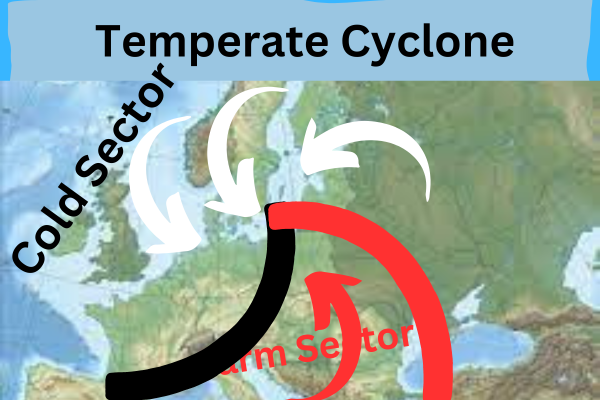Temperate Cyclones in Europe

Table of Contents
Unleashing the Power of Temperate Cyclones in Europe
Temperate Cyclones in Europe | Introduction
Temperate Cyclones in Europe : Europe, a continent known for its diverse climate, experiences a significant influence from temperate cyclones. These dynamic weather systems, also referred to as extratropical cyclones, play a crucial role in shaping the region’s weather patterns. From powerful storms to dramatic temperature swings, temperate cyclones bring a myriad of atmospheric changes that leave a lasting impact on European landscapes and livelihoods.
Understanding Temperate Cyclones
Temperate cyclones are low-pressure systems that form in the mid-latitudes, typically between 30° and 60° N. They arise along the polar front, where contrasting air masses collide—warm air from the south meets cold air from the north. The temperature contrast creates a steep pressure gradient, leading to the formation of these cyclones. Unlike their tropical counterparts, temperate cyclones derive energy from the temperature contrasts rather than warm ocean waters.
Warm Front and Cold Front
In a temperate cyclone, a warm front and a cold front are two types of fronts that typically form and interact with each other.
- Warm Front: A warm front occurs when warm air advances and replaces colder air. As the warm air mass moves into an area occupied by cooler air, it rises over the colder air, forming a gradual slope. Warm fronts are associated with stratiform clouds, steady precipitation, and a gradual change in weather conditions from cool to warm.
- Cold Front: A cold front forms when a cold air mass advances and displaces a warmer air mass. The boundary between the two air masses is steep and defined. Cold fronts are often associated with cumuliform clouds, intense precipitation, and rapid weather changes. As a cold front passes through an area, temperatures drop, and weather conditions become cooler and drier.
In a temperate cyclone, the warm front usually develops ahead of the cold front. The warm front advances more slowly than the cold front and produces a more gradual change in weather conditions. As the cyclone intensifies, the cold front catches up to the warm front, eventually overtaking it. The interaction between the warm and cold fronts contributes to the cyclone’s dynamics and the associated weather patterns.
Weather Effects

When a temperate cyclone approaches Europe, it brings a host of weather phenomena. Stormy conditions, characterized by intense winds, heavy rainfall, and even snowfall in colder months, are common occurrences. These cyclones are known for their ability to generate gale-force winds, posing risks to coastal regions. The associated precipitation can lead to flash floods, which can cause significant damage to infrastructure and disrupt daily life.
Furthermore, temperate cyclones often result in rapid temperature changes. As the system passes through an area, it can bring warmer air from the south, leading to a sudden rise in temperatures. Conversely, cold air from the north may follow, causing a sharp drop in temperatures. These fluctuations can challenge people’s ability to adapt and may impact agricultural practices and local ecosystems.
Impacts on Society and Economy
The effects of temperate cyclones extend beyond the realm of weather. Storm-related power outages, transportation disruptions, and damage to buildings and infrastructure can cause significant economic losses. Additionally, the increased frequency and intensity of storms associated with these cyclones can threaten coastal areas with erosion, flooding, and even coastal inundation.
However, temperate cyclones also offer certain benefits. They contribute to the distribution of precipitation, essential for maintaining water resources and supporting agriculture. Moreover, they play a role in the natural cleansing of the atmosphere by dispersing pollutants and bringing fresh air masses from distant regions.
Conclusion
Temperate cyclones are a defining feature of Europe’s weather system. They bring about dynamic changes, including stormy conditions, precipitation variations, and temperature fluctuations. While their impacts can be disruptive and costly, temperate cyclones also provide necessary precipitation and air quality improvements. Understanding and forecasting these weather systems are crucial for mitigating risks, managing resources, and ensuring the safety and well-being of Europe’s inhabitants. Through scientific advancements and effective disaster preparedness, we can adapt to and harness the power of temperate cyclones while minimizing their adverse effects on society and the economy.